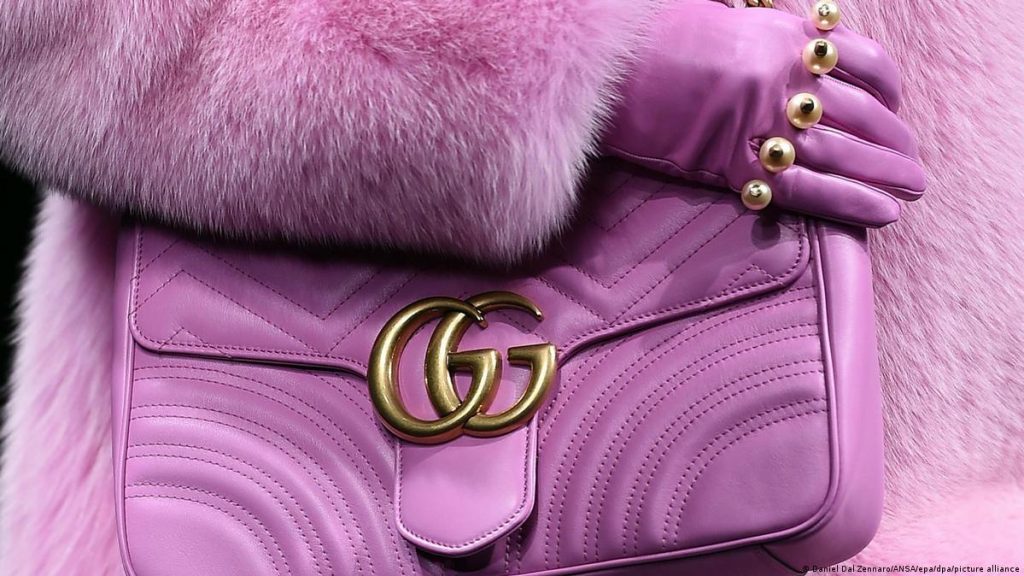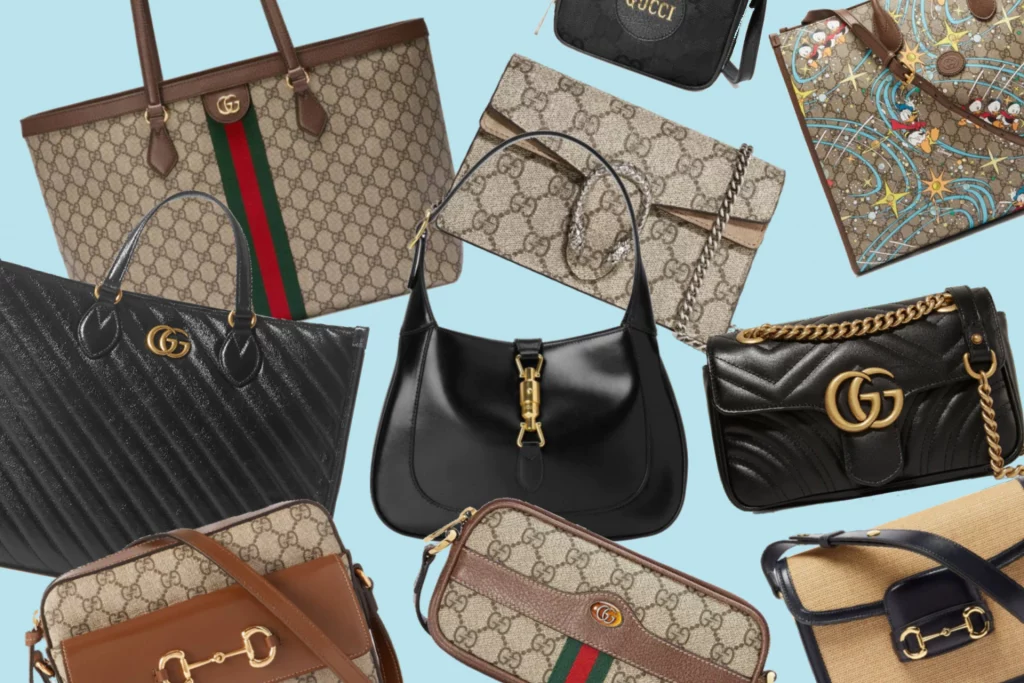Gucci’s marketing mix analyzes Gucci’s 4Ps including product, price, place, and promotion. The Gucci marketing mix places great emphasis on product placement, product portfolio, pricing strategy, promotional activities, and physical evidence of the Gucci brand. Owning Gucci products and other accessories is a status symbol, so buyers are ready to buy from premium brands.
An important aspect of Gucci’s marketing strategy is to maintain the company’s visually appealing appearance in its target market. The marketing objective behind the Gucci Marketing Mix Framework is to maintain high status, connect with Gucci customers, and achieve business objectives.
Introducing Gucci
#Gucci
Country of origin: Italy Founder: Guccio Gucci Former creative director: Alessandro Michele Current creative director: Sabato de Samo Parent company: Kering Founded: 1921 Headquarters: Florence, Tuscany, Italy Brand value: 18.1 billion USD (2023)
Italian fashion brand Gucci by Guccio Gucci is one of the most coveted luxury brands in the world. The brand name is synonymous with high-end quality, status symbols for women, and exorbitant prices. Innovative and influential are the words that come to mind when describing the company, as the luxury brand consolidates its position as one of the most desirable fashion houses in the global fashion industry.
The products and services provided by luxury brands are unparalleled in both quality and attention to detail. Gucci’s entire product line and portfolio is the best of Italian craftsmanship, which makes the company popular among its target audience.
Gucci’s product strategy


Gucci started out as a leather goods manufacturer and has become one of the world’s most prestigious luxury fashion brands. This Italian fashion brand is an important player in the personal luxury goods market. A third of its market value comes from sales of other accessories such as handbags and luxury watches.
In the Gucci framework, branded products are at the top due to product innovation, premium design and high-quality materials. With the help of Gucci’s marketing strategy, the brand has made Gucci products seem very expensive and superior to the customers. It helps maintain a premium brand tag that is visually appealing in the fashion world.
As of 2024, Gucci’s product mix is extensive and diverse, reflecting its established position as a leading luxury fashion brand.
Gucci’s new product mix for 2023 is as follows (source).
Handbags: Various bags such as shoulder bags, mini bags, top handle bags, clutches, belt bags, daily bags and tote bags are famous for their craftsmanship and designs. Travel accessories: This category includes travel bags, trolleys, travel accessories, and hard-sided bags. Ready-to-wear: Gucci offers a wide range of clothing including outerwear, knitwear, skirts, activewear, denim, swimwear, and more. Footwear: A comprehensive collection of boots, ballet flats, sneakers, mules, loafers, pumps, sandals, and dress shoes. Accessories: wallets, pouches, card holders, belts, hats, jewelry, socks, tights, scarves, eyewear, etc. Home decor: items such as furniture, wallpaper, textiles, home accessories, and tableware. Lifestyle products: Includes loungewear, sporting goods, leisure goods, stationery, etc. Pet Collection: Consists of pet household items, pet clothes, and pet accessories. Beauty Products: A selection of cosmetics and fragrances including lipstick, eyeliner, blush, nail polish, foundation, and more.
gucci place strategy
Gucci’s marketing mix and distribution strategy places great emphasis on location combinations. The company has a product presence in an estimated 501 retail or specialty stores worldwide. We have operations in the United States, Australia, Europe, Asia and the Middle East.
Gucci’s place strategy is characterized by a focus on exclusivity and accessibility in the luxury market.
Global Retail Network: Gucci maintains an extensive global presence with 501 specialty stores around the world, ensuring access to luxury products across different continents. Luxury Store Locations: The brand strategically locates its boutiques in upscale, high-traffic areas to attract elite customers. Direct sales and personalized service: Gucci emphasizes direct sales in its boutiques and provides personalized services to improve the customer experience. Online Sales Platform: The Company has a strong online sales channel, with products available in more than 25 markets through its own and third-party e-commerce platforms. Efficient distribution and inventory management: Gucci uses automated systems for efficient inventory management and uses both internal and third-party transportation to deliver products.
gucci pricing strategy
Gucci’s marketing mix is significantly focused on its product portfolio to capture its target market, as a significant portion of its revenue is derived from leather products, followed by shoes and then ready-to-wear clothing. The products offered are categorized according to the raw materials used, Gucci’s customers, competitors, and sales to determine the appropriate pricing strategy.
Gucci is one of the leading luxury fashion brands in the industry, so the raw materials used are of the highest quality. Additionally, the work done on the fabric creates a higher quality product, which increases the overall cost and makes it more expensive.
Gucci’s pricing strategy is carefully designed to maintain its position as a luxury brand.
Premium Pricing Strategy: Gucci employs a premium pricing model that aligns prices with the brand’s high quality and luxury status. Psychological pricing approach: The brand leverages psychological pricing, where higher prices are associated with superior quality, catering to consumers who equate price with value. Selective discounts for market penetration: Gucci implements discount strategies from time to time to attract younger demographics, during which it offers high quality products at more affordable prices.
gucci promotion strategy


Gucci’s promotional strategy in its marketing mix focuses on digital and social media marketing using various social media platforms, fashion shows with creative designers, traditional media advertising strategies, and modern packaging.
In recent years, creative director and designer Alessandro Michele has been fully involved in the company’s advertising strategy, driving advertising and digital marketing campaigns. He is credited with building Gucci into one of the most valuable luxury brands of its time.
traditional media
Gucci’s advertising strategy focuses on promotion and advertising through traditional media such as luxury fashion magazines, billboards, and banners. Gucci also leverages digital marketing campaigns to increase brand awareness. Gucci has recently launched some TV ads, but in most cases the brand prefers to use print media over TV ads.
social media marketing
Social media is one of the best brand advertising tools of our time. Gucci’s advertising and digital marketing campaigns run on social media platforms such as Tumblr, Instagram, YouTube, Pinterest, and Facebook.
As part of Gucci’s marketing strategy, various bloggers are employed to promote the brand’s advertising and content through its social media pages and various social media platforms. The Gucci Style App, released by Gucci in eight languages, includes interactive videos, location tips, fashion, and more.
Image-driven content
With this advertising strategy, the company delighted consumers and established its dominance as one of the industry’s iconic luxury brands. Advertising is Gucci’s forte, and the brand publishes visually rich content on its website featuring Gucci campaigns and collections.
Website redesign and relaunch
As part of its advertising strategy, Gucci ensures that all its online stores offer a unique experience to its customers. Ready-to-wear collections are hand-picked when they appear in runway fashion shows. Gucci provides customer service options on every product page on its website, so interested customers can contact a sales representative if needed.
Gucci and celebrities: Gucci’s marketing strategy
As part of Gucci’s advertising strategy, Gucci collaborated with Lady Gaga, who sang the national anthem at the 2016 Super Bowl wearing Gucci suit pants designed by creative director Alessandro Michele. Gucci has also collaborated with Harry Styles, Grace Kelly and Tom Ford.
At the BRIT Awards, Harry Styles turned heads in a vintage Gucci look that had everyone’s attention. Grace Kelly was the inspiration for Gucci’s signature floral prints that we all love. Who can forget the days of Tom Ford, when Gucci wore unbuttoned button-downs at various fashion shows?
Adidas and Gucci’s collaboration has resulted in some of the best releases and signature athletic silhouettes.
sustainability and gucci
Gucci’s marketing mix focuses on the company’s commitment to sustainability as part of its promotional strategy. To protect nature, we have developed low-impact materials and environmentally friendly sourcing solutions. Gucci uses green colors on its product packaging, which reduce the use of ink and are made from sustainably managed forest resources. Gucci has also eliminated the use of plastic in shipping its products.
Memorable marketing campaigns: Gucci’s marketing strategy
Some of the memorable digital marketing campaigns in Gucci’s marketing strategy include:
GG Marmont Collection
Lensed by Dazed, the GG Marmont Collection features Daisy Edgar-Jones in the ad campaign.
Gucci 25H
In the GUCCI 25H campaign, Jessica Chastain ponders the concept of time.
Gucci Valigeria
Ryan Gosling will star in the Gucci Valigeria campaign, which reflects the brand’s travel vision.
Here are Gucci’s recent video and print ads:
Liked this post? Check out the entire Marketing Mix series


